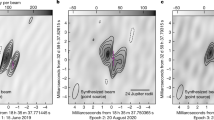Abstract
All ‘solar-like’ stars1 are surrounded by coronae2, which contain magnetically confined plasma at temperatures above 106 K. (Until now, only the Sun's corona could be observed in the optical—as a shimmering envelope during a total solar eclipse.) As the underlying stellar ‘surfaces’—the photospheres—are much cooler, some non-radiative process must be responsible for heating the coronae. The heating mechanism is generally thought to be magnetic in origin, but is not yet understood even for the case of the Sun. Ultraviolet emission lines first led to the discovery of the enormous temperature of the Sun's corona3,4, but thermal emission from the coronae of other stars has hitherto been detectable only from space, at X-ray wavelengths. Here we report the detection of emission from highly ionized iron (Fe XIII at 3,388.1 Å) in the corona of the red-dwarf star CN Leonis, using a ground-based telescope. The X-ray flux inferred from our data is consistent with previously measured X-ray fluxes, and the non-thermal line width of 18.4 km s-1 indicates great similarities between solar and stellar coronal heating mechanisms. The accessibility and spectral resolution (45,000) of the ground-based instrument are much better than those of X-ray satellites, so a new window to the study of stellar coronae has been opened.
This is a preview of subscription content, access via your institution
Access options
Subscribe to this journal
Receive 51 print issues and online access
$199.00 per year
only $3.90 per issue
Buy this article
- Purchase on Springer Link
- Instant access to full article PDF
Prices may be subject to local taxes which are calculated during checkout


Similar content being viewed by others
References
Linsky, J. L. Non radiative activity across the H-R diagram—Which types of stars are solar-like? Sol. Phys. 100, 333–362 (1985).
Schmitt, J. H. M. M. Coronae on solar-like stars. Astron. Astrophys. 318, 215–230 (1997).
Grottian, W. Zur Frage der Deutung der Linien im Spektrum der Sonnenkorona. Naturwissenschaften 27, 214 (1939).
Edlén, B. Die Deutung der Emissionslinien im Spektrum der Sonnenkorona. Z. Astrophys. 22, 30–62 (1942).
Taylor, A. R. & Paredes, J. M. (eds) Radio Emission from the Stars and the Sun (ASP Conf. Ser. 93, Astronomical Society of the Pacific, San Francisco, 1996).
Vaiana, G. S. et al. Results from an extensive Einstein stellar survey. Astrophys. J. 244, 163–182 (1981).
Guillout, P. et al. The stellar content of soft X-ray surveys. II. Cross-correlation of the ROSAT All-Sky Survey with the Tycho and Hipparcos catalogs. Astron. Astrophys. 351, 1003–1015 (1999).
Linsky, J. L., Wood, B. E., Brown, A. & Osten, R. A. Dissecting Capella's corona: GHRS spectra of the Fe XXI 1354 and He II λ 1640 lines from each of the capella stars. Astrophys. J. 492, 767–777 (1998).
Wallerstein, G., Böhm, K. H. & Oke, J. B. in Extreme Ultraviolet Astronomy (eds Malina, R. F. & Bowyer, S.) 113 (Pergamon, New York, 1991).
D'Odorico, S., Kaper, L. & Kaufer, A. VLT UVES Manual at 〈http://www.eso.org/instruments/uves/userman/〉 (2000).
Robinson, R. D., Carpenter, K. G., Percival, J. W. & Bookbinder, J. A. A search for microflaring activity on dMe flare stars. I. Observations of the dM8e star CN Leonis. Astrophys. J. 451, 795–805 (1995).
Barbera, M., Micela, G., Sciortino, S., Harnden, F. R. Jr & Rosner, R. X-ray emission at the low-mass end—Results from an extensive Einstein Observatory survey. Astrophys. J. 414, 846–866 (1993).
Schmitt, J. H. M. M., Fleming, T. A. & Giampapa, M. S. The X-ray view of the low-mass stars in the solar neighborhood. Astrophys. J. 450, 392–400 (1995).
Arnaud, M. & Raymond, J. Iron ionization and recombination rates and ionization equilibrium. Astrophys. J. 398, 394–406 (1992).
Flower, D. R. & Pineau Des Forets, G. Excitation of the FeXIII spectrum in the solar corona. Astron. Astrophys. 24, 181–192 (1973).
Harris, D. E. et al. The Einstein Observatory Catalog of IPC X-ray Sources, Vol. 4 (Smithsonian Astrophysical Observatory, Cambridge, Massachusetts, 1990).
Cheng, C., Doschek, G. A. & Feldman, U. The dynamical properties of the solar corona from intensities and emission line widths of EUV forbidden lines. Astrophys. J. 227, 1037–1046 (1979).
Chae, J., Schühle, U. & Lemaire, P. SUMER measurements of non thermal motions: Constraints on coronal heating mechanisms. Astrophys. J. 505, 957–973 (1998).
Acknowledgements
The data reported in this paper were collected at ESO's Paranal Observatory. We gratefully acknowledge the support of the ESO staff. We also thank D. Flower for discussions on Fe XIII.
Author information
Authors and Affiliations
Corresponding author
Rights and permissions
About this article
Cite this article
Schmitt, J., Wichmann, R. Ground-based observation of emission lines from the corona of a red-dwarf star. Nature 412, 508–510 (2001). https://doi.org/10.1038/35087513
Received:
Accepted:
Published:
Issue Date:
DOI: https://doi.org/10.1038/35087513
This article is cited by
-
On books and chemical elements
Foundations of Chemistry (2008)
Comments
By submitting a comment you agree to abide by our Terms and Community Guidelines. If you find something abusive or that does not comply with our terms or guidelines please flag it as inappropriate.



